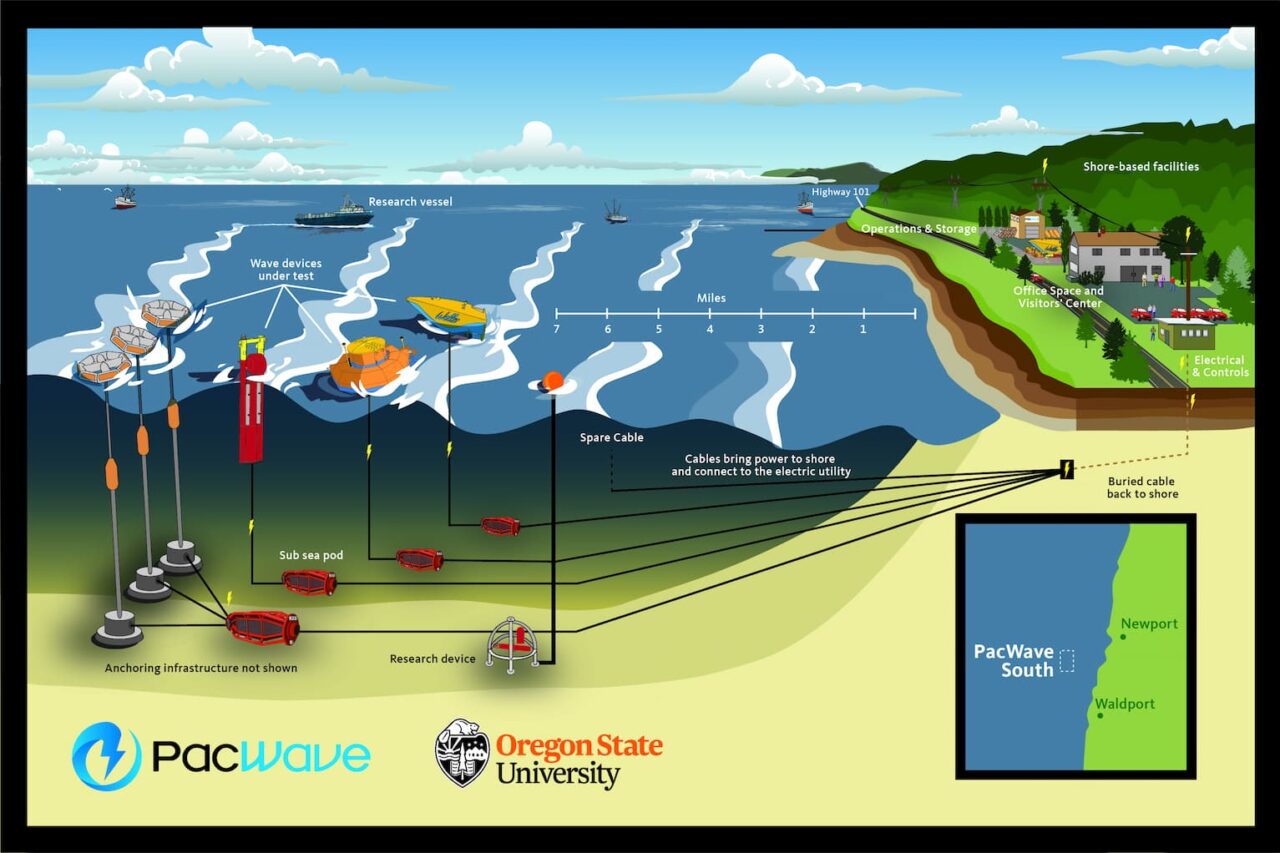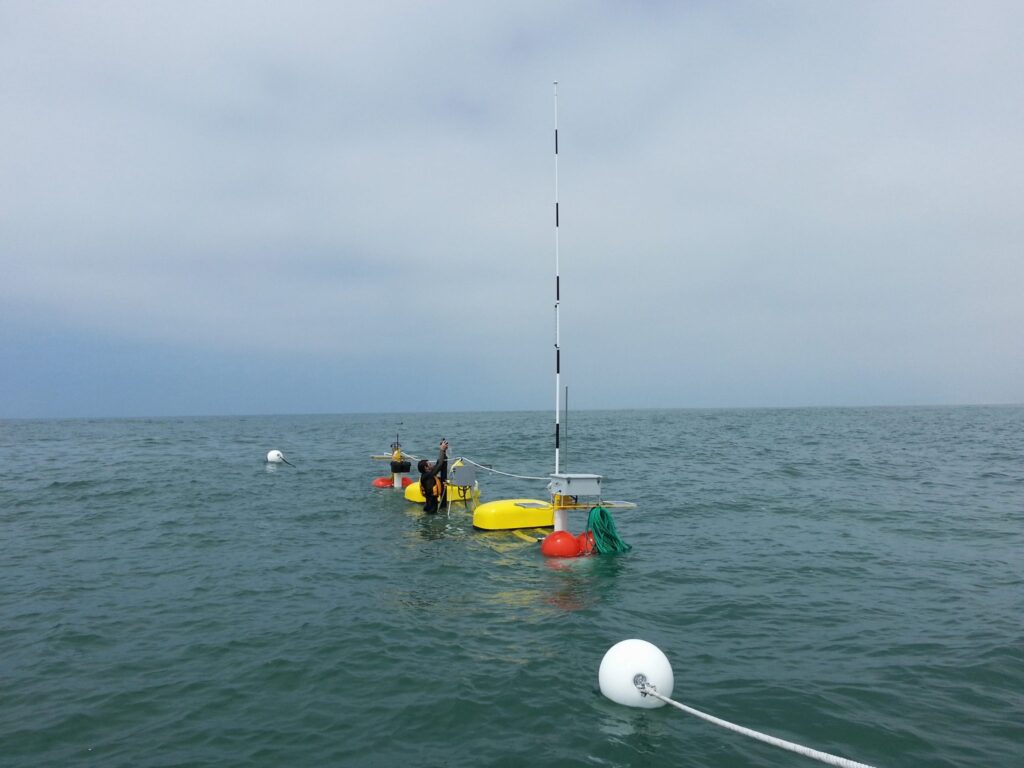
Eight ocean energy projects representing the first round of open-water testing at the 20-MW PacWave South wave energy test site off the Oregon coast have garnered a combined $ 25 million in federal funding to support technology research, development, and demonstration at the trailblazing facility.
The U.S. Department of Energy’s (DOE’s) Water Power Technologies Office (WPTO) on Jan 25 announced the project selections as part of its “Advancing Wave Energy Technologies through Open Water Testing at PacWave.” The project selections are notable because they are among the first at an actual open-water test facility that is dedicated to accelerating wave energy technology to commercial viability.
PacWave South: Pioneering Testing in Open Ocean Conditions
“Waves are created when wind blows over the surface of open water in the ocean, and this movement results in a large amount of natural energy,” explained WTOP. To capture this energy and convert it to carbon-free electricity, researchers use WECs, but “advancing wave energy converters requires testing in realistic conditions,” it noted. “However, testing in the open ocean is difficult due to permitting challenges and the few available test sites.”
PacWave South is one of two test areas located off the Pacific Coast near Newport, Oregon. PacWave North, already an established site for small-scale prototype and maritime market technologies, is sited two miles off the coast in shallower waters and closer to port than PacWave South. PacWave South, whose construction began on June 2021, is sited seven miles off the coast on the outer continental shelf in the Pacific Ocean. When completed in 2023, the open ocean test site will consist of four berths, which will occupy two square nautical miles of ocean with a cable route to shore of approximately 12 miles in length.
The site is permitted for the testing of up to 20 wave energy converters at the four berths, allowing different technologies to be tested at the same time. The total facility will have a maximum power output of up to 20 MW. Each berth will have a dedicated, 5-MW-capable power and data cable connection to the utility connection and monitoring facility on the shore.

PacWave South stems from a 2016 competitive $ 35 million award by the DOE to Oregon State University (OSU) to permit, design, build, and operate the open-water wave energy test facility. In March 2021, the Federal Energy Regulatory Commission granted a license to build and operate the facility, culminating “an unprecedented regulatory process that spanned nearly 10 years,” OSU said. According to WPTO, when completed PacWave South will be the nation’s “first accredited, grid-connected, pre-permitted, open-water wave energy test facility.”
Innovative Wave Energy Converter Technologies
However, the DOE’s awards this week are also notable for the array of innovative wave energy converter (WEC) technologies they will support. Selected projects include:
CalWave 50-kW Pilot at PacWave. Oakland, California–based CalWave Power Technologies and partners American Bureau of Shipping, Eaton Corp., Evergreen Innovations, Fluor, Glosten Associates, Sause Brothers, and Thompson Metal Fab. will get $ 7.5 million to deploy and test CalWave’s 50-kW xWave WEC device at PacWave. “The goal of this project is to advance the technology’s efficiency and increase its cost-effectiveness,” WPTO said.

Autonomous Offshore Power. Virginia-based Columbia Power Technologies and partners EC-OG, Sea Engineering, 48 North Solutions, EOM Offshore, Viasat/Rignet, DNV-GL, Durham & Bates, Vicor, Cardinal Engineering, and Harris Thermal will use their $ 4.2 million award to advance Columbia Power Technologies’ SeaRAY k2 autonomous offshore power system (AOPS) to commercial readiness. “The SeaRAY k2 AOPS consists of the SeaRAY k2 WEC with fully integrated station keeping (or the ability to perform adjustments to maintain its position) and the capacity to collect and send data and store energy. It is designed to support unmanned offshore activities and equipment, including subsea vehicles, sensor packages, and operating equipment,” said WPTO.
Multi-Mode Point Absorber. Oscilla Power and partners Applied Control Engineering, Applied Motion Systems, DNV-GL; Glosten Associates, Spencer Fluid Power, and Marine Systems Modelling will work to make performance improvements to the Triton WEC identified during previous WPTO-funded projects. The team will also develop a detailed design for a system that can be tested at the PacWave facility and generate design drawings in preparation for construction of the device. The project will get $ 1.8 million in DOE funding.
‘Centipod’ WEC Design. California-based Dehlsen Associates will also get $ 1.8 million to design the Centipod 1P6 (C1P6), a point absorber WEC. “A point absorber is a smaller type of WEC, relative to average wave sizes, that can absorb energy using a floating buoy tethered to a fixed reference point,” WPTO explained. “The C1P6 uses a small, controllable power take-off system, which turns the energy absorbed from the wave into electricity.” The WEC also uses an inflatable float that offers the potential for significant cost improvements, the WPTO said. Project partners include: Tension Technology International, Elliot Bay Design Group LLC, McCleer Power Inc, DNV, Cinch Inc, Flexlife Group Inc, and the University of New Hampshire.

Smart Absorber System. Awarded $ 4 million as part of a project that “will advance the marine energy industry as a whole,” Massachusetts-based Littoral Power Systems will combine machine learning and predictive modeling with a novel lightweight multi-axis point absorber system. “This project aims to deploy the NeuralWEC with the goal of demonstrating that the use of sensor‐based and artificial intelligence-enabled supervisory controls in real-world sea states can double a WEC’s cost efficiency,” said WPTO. Project partners include industry heavyweights GE Research, Rohrer Technology Inc., RTI Wave Energy, Kelson Marine Co., and Ballard Marine Construction. Marquette University will also be a key partner.
Open-Water Testing of an Electromagnetic Resonant Power Take-off Generator. Portland State University and AquaHarmonics; CalWave Power; FluxMagic, Inc.; Oscilla Power; and Resolute Marine Energy, will meanwhile partner in another project that will get $ 4 million. The project plans to test and validate a new type of electromagnetic resonant power take-off WEC component technology. “Using this power take-off technology, a WEC may be able to generate power with a favorably low peak-to-average power ratio of 3:1,” said WPTO. A lower peak-to-average power ratio can indicate a design that is well matched to anticipated wave intensity, it explained.
Parametric Source Functions for WECs. The University of Washington and Integral Consulting will get $ 1.2 million to create a library of acoustic events that will help WEC developers and regulators address concerns about sound from WECs. “Researchers will make acoustic measurements at PacWave and then detect, localize, and identify sounds attributable to WECs,” WPTO said.
An Environmental Data Integration and Assessment Tool for Supporting Marine Energy Adaptive Management Frameworks. Integral Consulting in another project that will get $ 379 million will seek to develop and demonstrate an environmental data integration assessment (EDIA) tool to support effective environmental monitoring and adaptive management frameworks for marine energy projects. The EDIA tool will serve as a central repository for all environmental data collected at PacWave.
—Sonal Patel is a POWER senior associate editor (@sonalcpatel, @POWERmagazine).
The post DOE Picks First Marine Energy Projects for PacWave Test Site in Oregon appeared first on POWER Magazine.